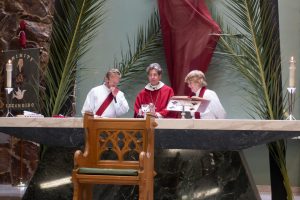What are they doing?? If you’ve never been to an Episcopal Church, you may have questions. Here, we have answers. Let’s walk through a Sunday and see:
What to Wear?
In dress, as in many issues, Trinity is a community of diversity. Some are casual, other members wear their Sunday best. Wear what is comfortable for you, and–here’s a unique fashion time–helps you (and your children) honor God and come into his presence with thanksgiving.
Entering the Church
Look around: this space is special. Not an auditorium, not a theater, the church building has feel and structure all its own. Symbols and strange furniture surround you. The music you hear is on no one’s play list. Worship can take place anywhere, but a sacred space helps us to focus on the purpose of our gathering. We leave business and conversation outside and enter the sacred space in body and in mind.
Worship Begins
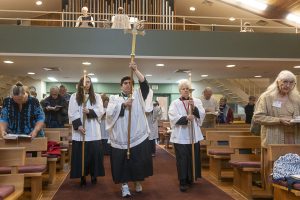 As the choir and worship leaders enter the church, the congregation sings a hymn. The procession draws our attention to the gathering. As you sing, note carefully the words of the hymn. Much of what we understand and believe about God enters our minds almost unconsciously from the repetition of the words of such hymns.
As the choir and worship leaders enter the church, the congregation sings a hymn. The procession draws our attention to the gathering. As you sing, note carefully the words of the hymn. Much of what we understand and believe about God enters our minds almost unconsciously from the repetition of the words of such hymns.
What’s With the Clothes?
Worship leaders wear vestments. Some have their roots in styles from the Church of England. Others recall scriptural images. White robes symbolize the clothing of the redeemed in the Book of Revelation. Priests wear a stole, symbolizing the yoke of Christ. At communion the celebrant wears a poncho called a chasuable, representing the seamless robe Jesus wore.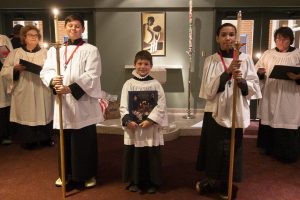
Colors? Candles?
The color-coded year is the church’s way of sanctifying time as the place of God’s revelation. Candles and other symbols recall the description of heavenly worship found in the Book of Revelation. To learn more about the symbols found in Trinity, take a tour (online soon).
Act I: The Liturgy of the Word
The service begins with praise to God. You may sing the Kyrie or the Gloria, both ancient hymns of praise. Our praise of God sets us to the primary task of worship: reminding ourselves of who we are and who God is. Knowing who God is as Creator, Redeemer and Sanctifier, and knowing ourselves as the recipients of grace and love, we will be empowered through worship to live as God desires. We will have the faith to be who we are meant to be.
Standing, Sitting, Kneeling
We worship with our bodies because we are human beings with bodies! Stand for praise, sit to listen, kneel to pray–that’s the general rule. We call it Episcopal aerobics, and the best way to participate is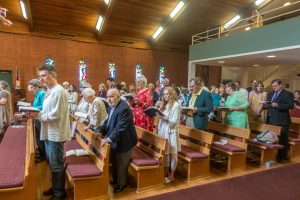 to just follow along as best you can.
to just follow along as best you can.
Bible Readings
On a typical Sunday, you will hear 4 portions of scripture: an Old Testament reading and a Psalm, a New Testament reading and a Gospel reading. Where do these pieces come from? The Episcopal church follows a 3-year cycle; which means that all Episcopal churches are reading the same lessons on a given Sunday. Following the lectionary, in 3 years most parts of the four Gospels will be read, as well as large portions of the rest of the New Testament. You may discern a common theme stretching through the readings. Using a lectionary insures that we will hear all of the messages of scripture, not just those we like best.
Words, Words, Words
The first part of the service prepares us to recommit to the faith. Praise gets us started. We hear and apply the story to our lives. “Prayers of the People,” raise up the concerns of our lives, our community and the world. We confess our sins, recognizing that we do not always live up to the true identity we have been given in Christ. Finally we hear the absolution, or reassurance of forgiveness. Thus reconciled to God, we exchange the Peace with one another, reassuring each other of our place in this community and in God’s Kingdom. All this is a preparation. We are now ready to turn to the second part of our service.
Act II: Holy Eucharist
Eucharist, another title for Holy Communion, means thanksgiving. Ultimately thanksgiving is all that we can give in response to God’s gifts of life and redemption. Yet as we offer thanks, we also receive the inspiration and strength we need to live as God’s people. This interchange of offering and receiving lies at the heart of Holy Communion.
The Offering
Some might call this part “taking up the collection,” but there’s more going on here. As the choir makes a musical offering, representatives of the congregation bring forward the bread and wine to be used in communion. As we offer the bread and wine for the sacrament, we are also offering ourselves to be inspired and used for God’s purposes. We are preparing ourselves to receive Christ’s presence and inspiration. What better symbol of offering ourselves than to give from our wallets? Thus we offer our treasure at this time.
The Great Thanksgiving
The prayer begins with a 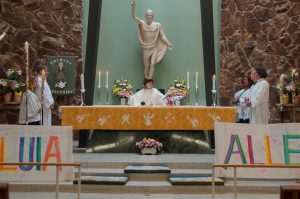 dialogue between the presiding priest and the congregation. This conversation, now of course in English, is the very same dialogue used by Christians to begin the Eucharist in the first centuries of the Church. It calls all of us to join in praise and thanksgiving. The prayer offered by the celebrant recalls the particular occasion being celebrated. All this culminates in the song called the Sanctus (Latin for holy), which is the song the prophet Isaiah heard sung in heavenly worship. Thus we unite with all of creation, seen and unseen, in praise of God.
dialogue between the presiding priest and the congregation. This conversation, now of course in English, is the very same dialogue used by Christians to begin the Eucharist in the first centuries of the Church. It calls all of us to join in praise and thanksgiving. The prayer offered by the celebrant recalls the particular occasion being celebrated. All this culminates in the song called the Sanctus (Latin for holy), which is the song the prophet Isaiah heard sung in heavenly worship. Thus we unite with all of creation, seen and unseen, in praise of God.
The Story
As the celebrant continues, you hear the story of salvation: our creation, fall and redemption through Jesus. Each week the same story: again and again we remind ourselves who we are, why we give thanks, and what we are becoming. We recall the promises made in the Gospel, of what we receive through faith for our living. With each hearing, the story becomes more a part of us; the source of our strength and inspiration.
Amen!
While the celebrant speaks alone, he or she speaks on behalf of the gathered community. Amen, the congregation responds. So be it. I mean that, too. The Eucharist is “a sacrifice of praise and thanksgiving.” That doesn’t sound like much of a sacrifice, until we realize all that it invites us to give up. To be people of thanksgiving: not of desire and demand, not of despair and helplessness – this is what we assent to with our Amen.
Take and Eat
The congregation comes forward to receive communion. All baptized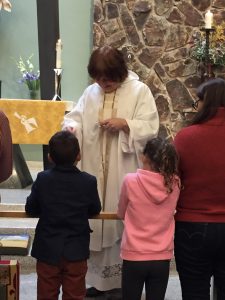 persons are welcome to receive, regardless of age or church background, because through baptism we have become members of the Body of Christ. As we receive communion, in some way we receive the presence and inspiration of Christ. He is here. We receive bread and wine, but so much more. We receive the grace of forgiveness and eternal life. We receive the Holy Spirit for strength and inspiration. We receive the renewal of faith and energy to go on in the Christian life.
persons are welcome to receive, regardless of age or church background, because through baptism we have become members of the Body of Christ. As we receive communion, in some way we receive the presence and inspiration of Christ. He is here. We receive bread and wine, but so much more. We receive the grace of forgiveness and eternal life. We receive the Holy Spirit for strength and inspiration. We receive the renewal of faith and energy to go on in the Christian life.
Wine?
Yes, in the Episcopal church wine is really used. We do so, following the example of Jesus. Wine remains a powerful symbol, both life-giving and dangerous, not unlike the inspiration of the Holy Spirit we celebrate. Not all members choose to receive the wine, while others dip the bread into the wine rather than drink. In all these ways, we receive Christ into our lives.
Let’s Go!
A short concluding prayer, a final blessing and hymn and the congregation is sent forth. Renewed by a deeper understanding of our call to be God’s people, inspired and strengthened through receiving the sacrament, we are ready to take on the world. As the liturgy says: Let us go forth to love and serve the Lord!

